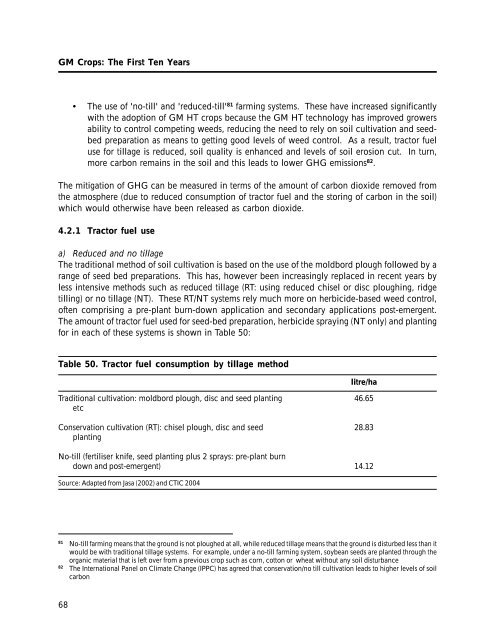GM Crops: The First Ten Years - International Service for the ...
GM Crops: The First Ten Years - International Service for the ...
GM Crops: The First Ten Years - International Service for the ...
Create successful ePaper yourself
Turn your PDF publications into a flip-book with our unique Google optimized e-Paper software.
<strong>GM</strong> <strong>Crops</strong>: <strong>The</strong> <strong>First</strong> <strong>Ten</strong> <strong>Years</strong><br />
• <strong>The</strong> use of 'no-till' and 'reduced-till' 81 farming systems. <strong>The</strong>se have increased significantly<br />
with <strong>the</strong> adoption of <strong>GM</strong> HT crops because <strong>the</strong> <strong>GM</strong> HT technology has improved growers<br />
ability to control competing weeds, reducing <strong>the</strong> need to rely on soil cultivation and seedbed<br />
preparation as means to getting good levels of weed control. As a result, tractor fuel<br />
use <strong>for</strong> tillage is reduced, soil quality is enhanced and levels of soil erosion cut. In turn,<br />
more carbon remains in <strong>the</strong> soil and this leads to lower GHG emissions 82 .<br />
<strong>The</strong> mitigation of GHG can be measured in terms of <strong>the</strong> amount of carbon dioxide removed from<br />
<strong>the</strong> atmosphere (due to reduced consumption of tractor fuel and <strong>the</strong> storing of carbon in <strong>the</strong> soil)<br />
which would o<strong>the</strong>rwise have been released as carbon dioxide.<br />
4.2.1 Tractor fuel use<br />
a) Reduced and no tillage<br />
<strong>The</strong> traditional method of soil cultivation is based on <strong>the</strong> use of <strong>the</strong> moldbord plough followed by a<br />
range of seed bed preparations. This has, however been increasingly replaced in recent years by<br />
less intensive methods such as reduced tillage (RT: using reduced chisel or disc ploughing, ridge<br />
tilling) or no tillage (NT). <strong>The</strong>se RT/NT systems rely much more on herbicide-based weed control,<br />
often comprising a pre-plant burn-down application and secondary applications post-emergent.<br />
<strong>The</strong> amount of tractor fuel used <strong>for</strong> seed-bed preparation, herbicide spraying (NT only) and planting<br />
<strong>for</strong> in each of <strong>the</strong>se systems is shown in Table 50:<br />
Table 50. Tractor fuel consumption by tillage method<br />
Traditional cultivation: moldbord plough, disc and seed planting<br />
etc<br />
Conservation cultivation (RT): chisel plough, disc and seed<br />
planting<br />
No-till (fertiliser knife, seed planting plus 2 sprays: pre-plant burn<br />
down and post-emergent)<br />
Source: Adapted from Jasa (2002) and CTIC 2004<br />
litre/ha<br />
46.65<br />
28.83<br />
14.12<br />
81 No-till farming means that <strong>the</strong> ground is not ploughed at all, while reduced tillage means that <strong>the</strong> ground is disturbed less than it<br />
would be with traditional tillage systems. For example, under a no-till farming system, soybean seeds are planted through <strong>the</strong><br />
organic material that is left over from a previous crop such as corn, cotton or wheat without any soil disturbance<br />
82 <strong>The</strong> <strong>International</strong> Panel on Climate Change (IPPC) has agreed that conservation/no till cultivation leads to higher levels of soil<br />
carbon<br />
68
















